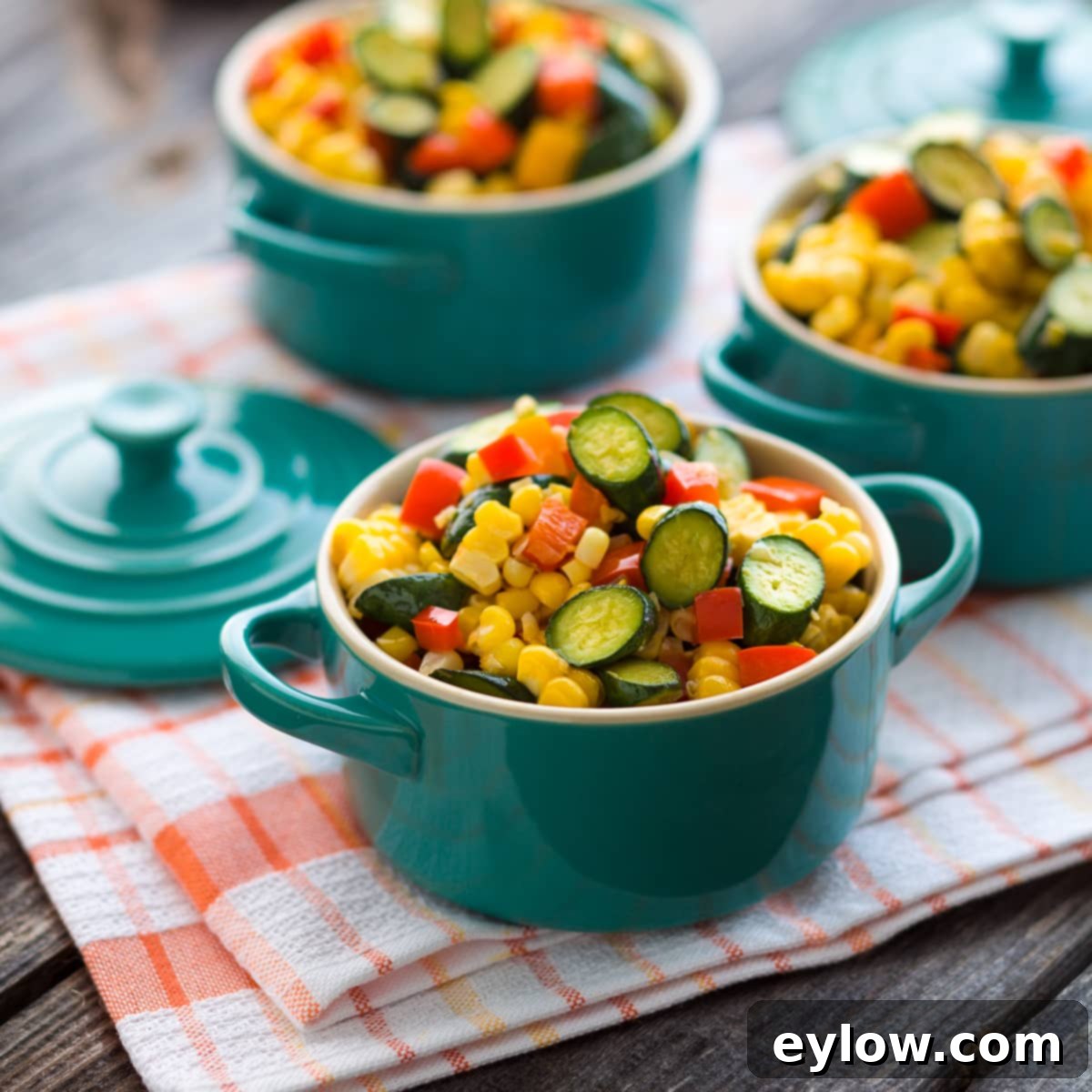Easy Sautéed Mixed Vegetables: Your Ultimate Healthy, Flavorful, and Customizable Side Dish
Discover the delightful simplicity of this easy sautéed mixed vegetables recipe, a vibrant side dish that quickly became a beloved family favorite. Praised by clients for its fresh flavors and effortless preparation, this healthy recipe makes the most of abundant summer produce like zucchini, sweet corn, and colorful bell peppers. Its versatility extends beyond summer, with endless ideas to adapt the vegetable mix to any season, ensuring healthy and delicious meals year-round. A sprinkle of fresh herbs at the end elevates the flavors, making this a must-add to your collection of quick and easy recipes.
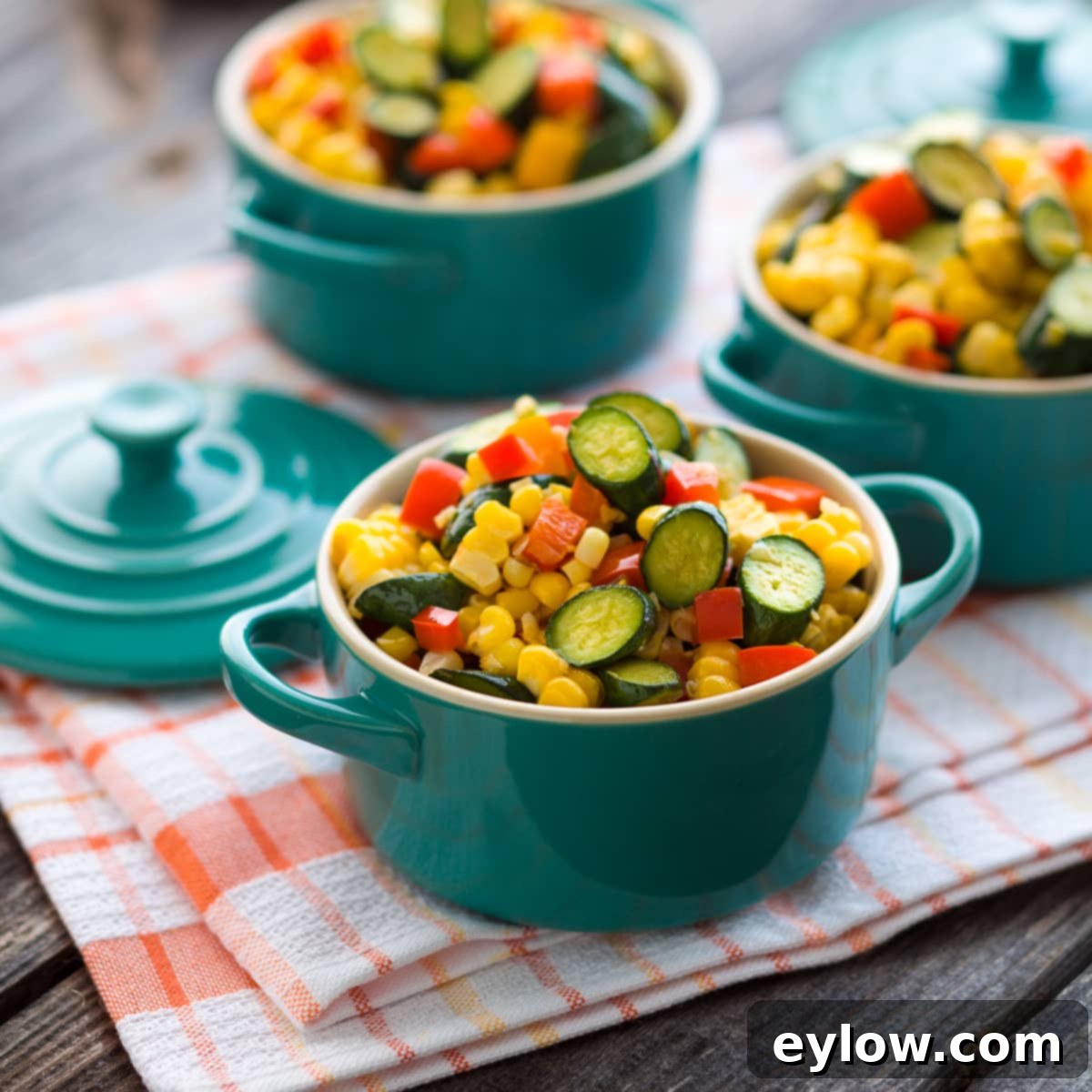
The original combination of tender zucchini, sweet kernels of corn, and crisp sweet bell peppers was an instant hit. This vibrant medley is not just incredibly tasty; it’s also a fantastic way to encourage everyone, especially those pickier eaters in your family, to enjoy their vegetables. The rich array of colors, diverse textures, and harmonious flavors transform simple vegetables into an exciting culinary experience. Beyond its deliciousness, this sautéed vegetable medley offers a significant nutritional boost, packed with essential vitamins, minerals, and fiber, making it an ideal choice for any health-conscious kitchen.
[feast_advanced_jump_to]
Essential Ingredients for Your Sautéed Vegetable Medley
Crafting this flavorful and healthy side dish requires a selection of fresh, high-quality ingredients. While the core components are simple, each plays a vital role in building the dish’s overall taste and texture. Below are the key ingredients you’ll need; precise measurements can be found on the recipe card further down:
- Fresh Corn: Sweet and juicy, fresh corn adds a delightful pop and natural sweetness to the medley. If fresh cobs aren’t in season, high-quality organic frozen kernels are an excellent substitute.
- Zucchini: Opt for baby zucchini or small to medium regular zucchini. Their mild flavor and tender texture make them perfect for quick sautéing, absorbing the flavors of the other ingredients beautifully.
- Red Bell Pepper: Contributes a beautiful vibrant color and a sweet, slightly fruity flavor.
- Orange Bell Pepper: Adds another layer of color and a distinct, mellow sweetness, enhancing the visual appeal and flavor profile.
- Extra-Virgin Olive Oil: The base for sautéing, it imparts a rich, fruity note and helps the vegetables cook evenly while providing healthy fats.
- Shallot: Minced or finely chopped, shallots offer a delicate, sweet, and aromatic flavor that is milder than onion, yet equally effective as a flavor enhancer.
- Garlic Cloves: Finely chopped, garlic is essential for its pungent, aromatic qualities that infuse the entire dish with depth and warmth.
- Fresh Herbs: Optional but highly recommended, fresh herbs like parsley, oregano, tarragon, or cilantro add a burst of freshness and elevate the overall aroma and taste.
- Salt: Essential for seasoning, it brings out the natural flavors of the vegetables.
- Black Pepper: Provides a subtle warmth and spice. You can also use red pepper flakes for an added kick if you prefer.
Smart Ingredient Tips and Seasonal Swaps
While fresh vegetables are always ideal for maximum flavor and nutrition in this sautéed mixed vegetable recipe, flexibility is key. Don’t hesitate to use frozen options when fresh isn’t available, or when you need to save time on prep. These tips and swaps will help you tailor the dish to your pantry and preferences:
- Corn: When fresh corn on the cob is out of season, high-quality organic frozen corn kernels are an excellent alternative. Ensure they are thawed thoroughly before cooking to prevent excess moisture from making the dish watery. Thawing also helps them integrate better with the other sautéed vegetables.
- Zucchini: For the best texture, opt for baby zucchini or smaller, regular zucchini. Larger zucchini can be watery and have more prominent seeds. If using larger ones, remember to trim out the seedy centers as detailed in our cutting guide below for a more refined texture.
- Shallot/Onion: If you don’t have shallots on hand, sweet onions or red onions are great substitutes. Sweet onions offer a milder flavor that won’t overpower the vegetables, while red onions can add a bit more bite and a lovely purple hue. Finely chop them to ensure they cook down evenly.
- Optional Fresh Herbs: Don’t limit yourself to the usual parsley. Experiment with other fresh herbs to change the flavor profile. Fresh oregano adds an earthy Mediterranean note, tarragon offers a delicate licorice-like aroma, and cilantro (coriander leaves) brings a vibrant, fresh, and slightly citrusy finish, particularly good if you’re leaning towards a Mexican-inspired meal. Always add fresh herbs at the very end of cooking to preserve their delicate flavor and color.
- Bell Peppers: While red and orange bell peppers are specified for their sweetness and color, feel free to use a yellow bell pepper for a bright, sunny touch or even a green bell pepper for a slightly more robust, less sweet flavor. Mixing colors makes the dish visually appealing and more exciting to eat.
- Garlic Powder: In a pinch, if fresh garlic isn’t available, a small amount of garlic powder can be used. Approximately ¼ to ½ teaspoon of garlic powder can replace two fresh cloves. Add it along with the shallots to allow its flavor to bloom.
- Spice it up: For those who enjoy a little heat, a pinch of red pepper flakes added with the garlic can introduce a subtle warmth without overpowering the fresh vegetable flavors.
Embracing Seasonal Variety: Year-Round Vegetable Medley Ideas
While this recipe shines with summer produce, its fundamental technique of quick sautéing allows for incredible flexibility, enabling you to enjoy healthy, colorful vegetable dishes throughout the year. The core goal remains: getting nutritious and delicious dinners on the table. Here are some ideas to vary your sautéed vegetable mix by season, ensuring your side dishes are always fresh and exciting:
- Spring Additions:
- Cooked Green Peas: Their vibrant green color and sweet flavor are perfect for spring. Add them towards the end, as they cook quickly.
- Asparagus Tips: Lightly blanched or thinly sliced, asparagus adds a distinct, slightly earthy flavor.
- Radishes: A very quick sauté can mellow their peppery bite, adding a unique crispness.
- Autumn Favorites:
- Small Chopped Broccoli Florets: Add a lovely crunch and earthy flavor. They might need a few extra minutes of sautéing or a quick blanch beforehand to achieve tender-crispness.
- Cooked Carrots: Chopped into small cubes, carrots add sweetness and a beautiful orange hue. Pre-cook them slightly, as they take longer to soften.
- Small Bits of Cooked Squash or Sweet Potatoes: Roasting or steaming these harder vegetables slightly before adding them to the sauté ensures they are tender. They bring a rich, sweet, and comforting flavor, perfect for cooler weather.
- Winter Warmers:
- Cooked Lima Beans: Offer a creamy texture and mild, buttery flavor.
- Cooked French Beans or Green Beans: Chopped small (across), these provide a classic, fresh taste and crisp-tender texture. Add them after the shallots and zucchini, but before the quicker-cooking bell peppers.
- Thinly Sliced Brussels Sprouts: A quick sauté can bring out their nutty flavor.
- Kale or Spinach: Roughly chopped, these leafy greens can be wilted into the medley at the very end, adding a boost of nutrients and a slightly bitter counterpoint.
When incorporating different vegetables, consider their cooking times. Harder vegetables like carrots, broccoli, or squash will need to be pre-cooked (blanched, steamed, or roasted) or added earlier to the pan to ensure they reach desired tenderness without overcooking the other ingredients. The goal is to achieve a medley where all components are perfectly cooked—crisp-tender and flavorful.
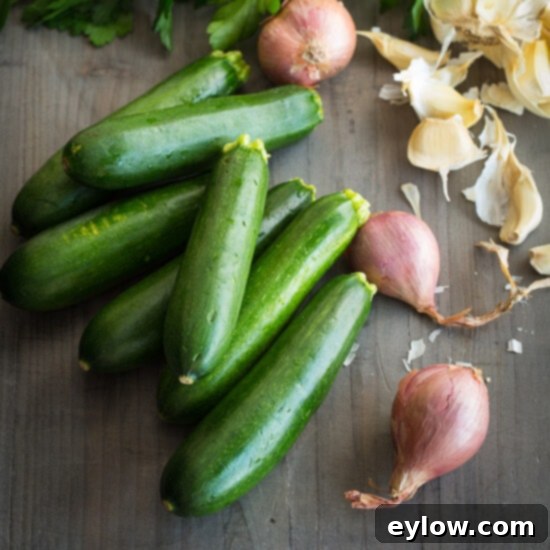
Mastering the Zucchini Cut for Optimal Texture
The way you cut your zucchini can significantly impact its texture and how evenly it cooks in a quick sauté. For this recipe, we aim for pieces that will become crisp-tender, not mushy, absorbing flavor beautifully. When choosing zucchini, smaller ones, especially baby zucchini, tend to be less watery and have fewer seeds, leading to a better final texture. Here’s how to prepare them:
If you’re using **baby zucchini**, the preparation is straightforward. Begin by trimming off the stem and blossom ends. Then, cut the whole baby zucchini on the diagonal into approximately ½-inch (1.5 cm) thick slices. Cutting on the diagonal not only looks appealing but also provides a larger surface area for browning and caramelization, enhancing the flavor during sautéing.
For **regular-sized zucchini**, a slightly different approach is needed to manage their size and seedier centers. First, wash and trim both ends. Then, slice the zucchini lengthwise into quarters. This creates four long, somewhat triangular strips. Next, carefully trim out the seedy, watery centers from each quarter. This step is crucial for preventing the dish from becoming too watery and ensuring a more pleasant texture. Once the centers are removed, cut these quartered strips on the diagonal into roughly ½-inch (1.5 cm) wide pieces. This method ensures uniform pieces that cook quickly and maintain their integrity in the medley.
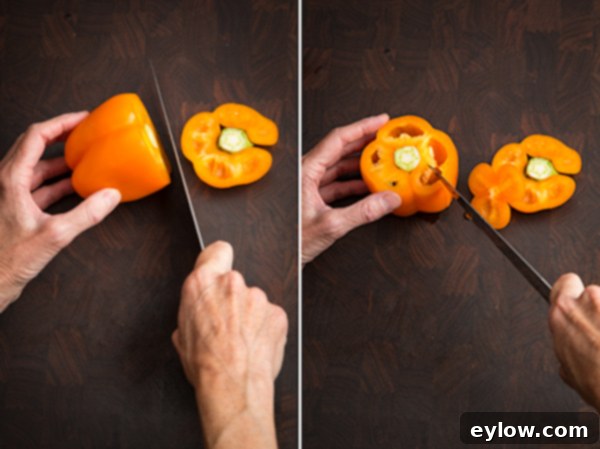
Efficiently Cutting Bell Peppers for Your Sauté
Cutting bell peppers can sometimes feel like a challenge, but with a simple technique, you can quickly and efficiently prepare them for your sauté. The goal is to remove the seeds and ribs while maximizing usable flesh for uniform pieces. Here’s a step-by-step guide to perfectly dicing your bell peppers:
1. **Preparation:** Start by washing your bell pepper thoroughly. Place it on a stable cutting board.
2. **Top and Bottom Removal:** Using a sharp chef’s knife, carefully slice off the very top and bottom ends of the bell pepper. Try to remove just enough to get rid of the stem and the tough base, keeping as much of the edible pepper as possible.
3. **Open the Pepper:** Stand the pepper upright on one of its cut ends. Then, make a single slice through the side of the pepper, from top to bottom. This will allow you to open the pepper up and lay it flat.
4. **Remove Seed Core:** Once the pepper is open and lying flat, you’ll easily see the large, central seed core and the white ribs attached to it. Carefully use your knife to remove this core, discarding it along with any loose seeds.
5. **Trim Ribs and Seeds:** Lay the pepper completely flat with the skin side down. Holding your knife parallel to the cutting board, trim out any remaining white ribs and seeds that are still attached to the flesh. These ribs are typically bitter and tougher, so removing them ensures a better texture and taste.
6. **Slice into Strips:** From here, cut the pepper into long, thin slices, approximately ¼-inch (0.6 cm) wide. The length will depend on the size of your pepper.
7. **Dice into Cubes:** Gather these long strips together, stacking them neatly. Then, cut across the strips to create perfect small cubes or squares, ideal for sautéing as they cook evenly and integrate well into the medley. This method results in beautifully diced pieces, ready for your dish.
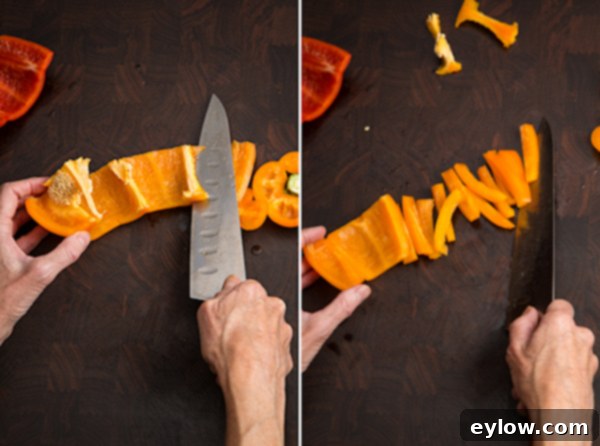
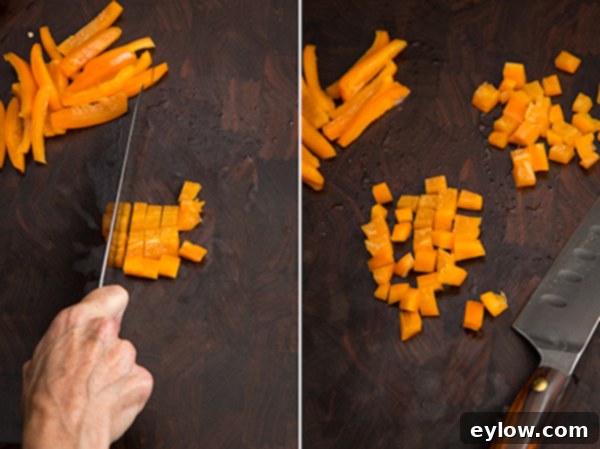
Preparing Fresh Corn: From Cob to Kernels
Using fresh corn kernels is a fantastic way to elevate the sweetness and texture of your sautéed vegetable medley. While frozen corn is a convenient alternative, preparing fresh corn from the cob is a simple process that yields superior flavor. Here’s how to do it efficiently and safely:
1. **Husk and Silk Removal:** Begin by removing the green husk and all the fine silken threads from the corn cobs. Peel back the husks and snap them off, then use a stiff brush or a damp paper towel to wipe away any stubborn silks.
2. **Quick Boil:** Bring a large pot of salted water to a rolling boil. Carefully drop the prepared corn cobs into the boiling water and cook for precisely three minutes. This brief blanching step helps to slightly cook the kernels, making them easier to cut off the cob and enhancing their natural sweetness. It also contributes to their beautiful, bright yellow color.
3. **Cool and Drain:** After three minutes, remove the corn cobs from the boiling water using tongs and drain them on a clean kitchen towel. Allow them to cool for a few minutes until they are comfortable enough to handle.
4. **Stabilize the Cob:** For easier and safer cutting, you can cut each cob in half across its width. This makes the cob shorter and more manageable. Alternatively, stand the whole cob upright in the center of a bundt pan or a large bowl. The hole in the bundt pan or the depth of the bowl will catch the kernels as you cut, preventing them from scattering.
5. **Cut the Kernels:** With a sharp knife, carefully stand the corn cob on one end (either the cut end if you’ve halved it, or the base). Starting from the top, slice downwards, cutting the kernels off the cob in long strips. Rotate the cob after each slice, working your way around until all the kernels are removed. Be careful not to cut too deeply into the cob itself, as this can release starchy, less flavorful bits.
6. **Set Aside:** Once all the kernels are off the cobs, collect them and set them aside, ready to be added to your sautéed vegetable medley.

Sautéing Your Perfect Vegetable Medley: Step-by-Step
Once all your vegetables are prepped – a task that can often be done ahead of time to make weeknight cooking even faster – this healthy side dish comes together remarkably quickly. The key to a delicious sauté is to cook the vegetables quickly over medium-high heat, allowing them to become crisp-tender and slightly caramelized, rather than steamed and soft. A good quality nonstick skillet or a large cast-iron fry pan will work perfectly for this.
1. **Heat the Oil:** Begin by heating the extra-virgin olive oil in your chosen large sauté pan over medium to medium-high heat. You want the oil to shimmer but not smoke, indicating it’s ready for cooking. A sufficient amount of oil is important for even cooking and preventing sticking.
2. **Sauté the Aromatics:** Add the finely chopped shallot (or onion) to the hot oil. Sauté for about 1 minute, stirring occasionally, until it becomes soft and fragrant. This step builds the aromatic foundation of your dish.
3. **Add Zucchini:** Introduce the prepared zucchini pieces to the pan. Cook for approximately 3-4 minutes, stirring frequently. The zucchini should start to soften slightly and develop a hint of golden-brown color.
4. **Incorporate Garlic and Bell Peppers:** Next, add the minced garlic and diced bell peppers to the pan with the zucchini. Stir everything well to combine. Continue to cook for another 4-6 minutes, or until the vegetables are softened to your liking and have developed some beautiful browning. The cooking time here is a matter of preference; some prefer their vegetables more tender, while others enjoy a firmer, crisp-tender bite.
5. **Add Corn and Finish:** Towards the very end of cooking, stir in the prepared corn kernels. If using fresh corn that was briefly boiled, it only needs about 1 minute to heat through. If using thawed frozen corn, it might need 2-3 minutes.
6. **Season and Serve:** Remove the pan from the heat. Stir in the fresh chopped herbs (if using), salt, and ground black pepper (or red pepper flakes). Taste and adjust seasoning as needed. Serve your vibrant sautéed mixed vegetables hot, immediately, to enjoy their optimal texture and flavor.
Remember, the beauty of sautéing is its speed and simplicity. Don’t overcrowd the pan, as this can lead to steaming instead of sautéing. If you’re making a large batch, it’s better to cook the vegetables in two smaller batches to ensure they get that desired crisp-tender finish.

Creative Ways to Serve Your Sautéed Vegetable Medley
This versatile sautéed vegetable medley is more than just a simple side; it’s a flavorful accompaniment that enhances a wide variety of main courses. Its vibrant colors and fresh taste make it suitable for almost any meal. Here are some inspiring ideas on how to serve this delicious dish:
- **Classic Pairings:** It makes an excellent, light side dish for heartier proteins. Serve it alongside a succulent whole roast chicken, tender roast bone-in chicken breasts, perfectly grilled chicken, or juicy burgers. It also pairs wonderfully with pan-seared fish like salmon or cod, grilled steak, or even pork chops.
- **Vegetarian/Vegan Delight:** For a complete vegetarian or vegan meal, toss the warm vegetable medley with cooked pasta, quinoa, or couscous. Add a drizzle of extra olive oil, a squeeze of lemon juice, and a handful of fresh basil for a light and satisfying main course.
- **Breakfast & Brunch Boost:** Leftovers (or even a fresh batch!) are fantastic folded into scrambled eggs or an omelet, adding color, flavor, and nutrition to your morning meal.
- **With a Cheesy Twist:** If your family, like many, enjoys everything better with cheese, a generous sprinkle of finely grated Parmesan cheese over the top of the warm mixed vegetables is always a winner. The salty, umami notes of Parmesan complement the sweetness of the vegetables beautifully.
- **Elegant Presentation:** For a charming touch, especially when entertaining, serve individual portions in small cocottes. These cute mini pots, like the ones from Le Creuset (available on Amazon in various colors), are perfect for side dishes and add a refined presentation to your table.
- **Wraps and Tacos:** Use the sautéed vegetables as a flavorful filling for warm tortillas or lettuce wraps, perhaps with a dollop of hummus or a sprinkle of feta cheese.
- **As a Base for Grain Bowls:** Layer them over a bed of brown rice, farro, or other grains, topped with a protein of your choice and a light dressing for a healthy and satisfying bowl meal.
Handling Leftovers: Storage and Reimagined Meals
One of the many benefits of this sautéed vegetable medley is how well it holds up, making for excellent leftovers that can be enjoyed the next day. Proper storage is key to maintaining freshness and flavor.
Once the vegetables have cooled completely to room temperature, transfer them to an airtight container. Refrigerate promptly, and they will stay fresh for up to 3-4 days. Avoid leaving them out at room temperature for extended periods to prevent spoilage.
When you’re ready to enjoy them again, you have several delicious options:
- **Simple Reheating:** The easiest way is to gently warm them up in a skillet over medium heat with a tiny bit of olive oil until heated through. You can also microwave them, though a skillet often helps retain a better texture.
- **Breakfast Transformation:** As mentioned, they are phenomenal for breakfast! Scramble them with eggs for a quick and nutritious start to your day, or fold them into a fluffy omelet for a more substantial meal. The vibrant colors and flavors add a gourmet touch to simple egg dishes.
- **Soup Booster:** Add leftover sautéed vegetables to a simmering vegetable broth or a chicken soup during the last few minutes of cooking. They will contribute extra texture, flavor, and nutrients to your soup.
- **Pasta Sauce Enhancer:** Stir them into your favorite pasta sauce or simply toss them with cooked pasta, a little pasta water, and some grated cheese for a light and quick meal.
- **Sandwiches and Wraps:** Use them as a flavorful addition to sandwiches, pitas, or wraps. They add moisture and a burst of flavor that complements various fillings.
- **Stir-fry Base:** Combine them with other proteins like chicken, tofu, or shrimp and a light sauce for a quick and easy stir-fry.
With these ideas, your delicious sautéed vegetables will never go to waste, providing quick and healthy meal options for days to come.
Explore More Delicious Vegetable Recipes
If you’re always on the lookout for new and exciting ways to enjoy vegetables, you’ve come to the right place! Vegetables are incredibly versatile, and there are countless methods to prepare them that enhance their natural flavors and textures. Expanding your repertoire of vegetable dishes is a fantastic way to boost your daily nutrient intake and add variety to your meals. If your family enjoys crisp and tender green beans, be sure to check out these 12 creative ways to dress them up, keeping things interesting and delicious at the dinner table. For those who appreciate the robust flavor of roasted vegetables, have you ever tried roasting broccoli? It transforms this humble cruciferous vegetable into a nutty, slightly sweet delight, especially when served with bright lemon and savory Parmesan, often accompanied by pine nuts for added texture. And if you find yourself with an abundance of fresh zucchini beyond what this sauté calls for, don’t let it go to waste! Explore the simplicity and smoky flavor of quick grilled zucchini, a perfect side for summer barbecues or a light addition to salads. Each of these recipes offers unique approaches to cooking vegetables, ensuring there’s always something new and appetizing to try.
📖 Recipe
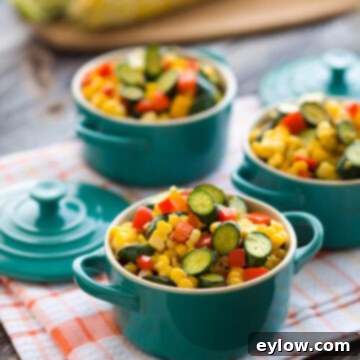
Colorful Summer Vegetable Medley
Sally Cameron
Pin Recipe
Equipment
-
Large saute or fry pan
Ingredients
- 2 large ears of fresh corn, husked and silk removed or 1 cup thawed organic frozen kernels, ensuring they are fully thawed and drained if using.
- 1 pound zucchini baby zucchini or small-to-medium regular, cut into ½-inch (1.5 cm) diagonal slices after trimming ends. For regular zucchini, remove seedy centers.
- 1 red bell pepper cored, seeded, and diced into small, uniform cubes.
- 1 orange bell pepper cored, seeded, and diced into small, uniform cubes. Yellow bell pepper is also a great alternative for color and sweetness.
- 1 tablespoon extra-virgin olive oil for sautéing, providing a rich flavor base.
- 1 large shallot or small onion finely chopped, to create an aromatic foundation.
- 2 garlic cloves finely chopped or minced, for robust flavor.
- 1 tablespoon fresh chopped herbs such as parsley, oregano, tarragon, or cilantro. This step is optional but highly recommended for a fresh finish.
- ¼ teaspoon sea salt or to taste, essential for seasoning.
- ¼ teaspoon ground black pepper or to taste. Red pepper flakes can be added for a subtle kick.
Instructions
Vegetable Prep Work (Can be done ahead of time)
-
To prepare fresh corn, bring a large pot of lightly salted water to a rolling boil. Once the water is boiling rapidly, carefully drop the husked and silked corn cobs into the pot. Boil for exactly 3 minutes. This quick blanching enhances sweetness and makes the kernels easier to remove. Remove the corn from the pot using tongs and drain them thoroughly on a clean kitchen towel. Allow the cobs to cool sufficiently so they can be handled comfortably. Once cool, stand each cob on its end and use a sharp knife to carefully cut the kernels off in long strips. Set the fresh kernels aside.
Alternatively, if using frozen corn kernels, ensure they are completely thawed and drained of any excess liquid according to package directions.
-
While the corn is cooking or cooling, begin preparing your zucchini and bell peppers. For the zucchini, start by trimming off both ends. If you are using baby zucchini, cut them crosswise into uniform ½-inch (1.5 cm) thick diagonal slices.
If you are using regular-sized zucchini, first cut them lengthwise into quarters. Then, carefully slice out and discard the seedy, watery centers from each quarter. This prevents the dish from becoming overly watery. Once the centers are removed, cut the zucchini strips on the diagonal into approximately ½-inch (1.5 cm) wide pieces.
For the bell peppers, wash them thoroughly. Cut off the top and bottom ends, then slice down one side to open them up flat. Remove all the seeds and white membranes (ribs) for a better taste and texture. Lay the pepper flat, skin side down, and cut into long, thin strips, then chop these strips into small, uniform cubes. Refer to the detailed photos and instructions in the “How to Cut Up a Bell Pepper” section above for visual guidance to achieve perfect dicing.
Cooking the Medley
-
Heat the extra-virgin olive oil in a large sauté pan or cast iron fry pan over medium to medium-high heat. Ensure the pan is adequately hot, but the oil is not smoking. Add the finely chopped shallot (or onion) to the hot oil and cook, stirring frequently, until it softens and becomes translucent, typically about 1 minute.
Next, add the prepared zucchini slices to the pan. Sauté for about 3-4 minutes, stirring occasionally. The zucchini should start to develop a light golden color and become slightly tender.
Now, add the minced garlic and the diced red and orange bell peppers to the pan. Stir everything together well to combine all the vegetables and aromatics. Continue to cook the vegetables for another 4-6 minutes, stirring intermittently, until they are softened to your desired crisp-tender consistency and show signs of light browning. The cooking time will vary based on your preference for how crisp or tender you like your vegetables.
Towards the very end of the cooking process, add the corn kernels to the pan. Stir them in and heat through for just about 1 minute, as they are already briefly cooked or thawed. This quick final step warms the corn without overcooking it.
Finally, remove the pan from the heat. Stir in any chopped fresh herbs (if you are using them), followed by the sea salt and ground black pepper. Taste the medley and adjust the seasoning as needed to suit your preference. Serve your vibrant, healthy sautéed mixed vegetables hot immediately to enjoy them at their best.
